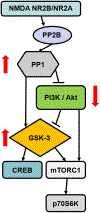Glycogen synthase kinase-3 signaling in cellular and behavioral responses to psychostimulant drugs
- PMID: 32454064
- PMCID: PMC7313643
- DOI: 10.1016/j.bbamcr.2020.118746
Glycogen synthase kinase-3 signaling in cellular and behavioral responses to psychostimulant drugs
Abstract
Glycogen synthase kinase-3 (GSK-3) is a serine/threonine kinase implicated in numerous physiological processes and cellular functions through its ability to regulate the function of many proteins, including transcription factors and structural proteins. GSK-3β has been demonstrated to function as a regulator of multiple behavioral processes induced by drugs of abuse, particularly psychostimulant drugs. In this review, we provide an overview of the regulation of GSK-3β activity produced by psychostimulants, and the role of GSK-3β signaling in psychostimulant-induced behaviors including drug reward, associative learning and memory which play a role in the maintenance of drug-seeking. Evidence supports the conclusion that GSK-3β is an important component of the actions of psychostimulant drugs and that GSK-3β is a valid target for developing novel therapeutics. Additional studies are required to examine the role of GSK-3β in distinct cell types within the mesolimbic and memory circuits to further elucidate the mechanisms related to the acquisition, consolidation, and recall of drug-related memories, and potentially countering neuroadaptations that reinforce drug-seeking behaviors that maintain drug dependence.
Keywords: Addiction; Amphetamine; Cocaine; Drug reward; Mesolimbic pathway; Neuroplasticity.
Copyright © 2020 Elsevier B.V. All rights reserved.
Conflict of interest statement
Declaration of competing interest The authors declare that they have no known competing financial interests or personal relationships that could have appeared to influence the work reported in this paper.
Figures



References
-
- Bals-Kubik R, Ableitner A, Herz A, & Shippenberg TS (1993). Neuroanatomical sites mediating the motivational effects of opioids as mapped by the conditioned place preference paradigm in rats. J Pharmacol Exp Ther, 264(1), 489–495. - PubMed
Publication types
MeSH terms
Substances
Grants and funding
LinkOut - more resources
Full Text Sources

